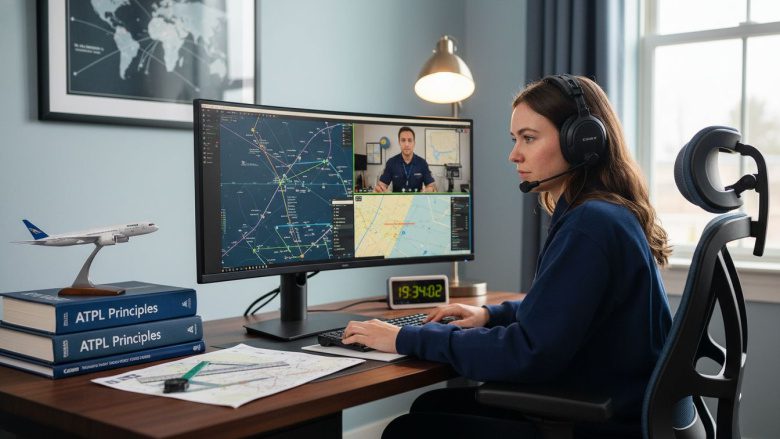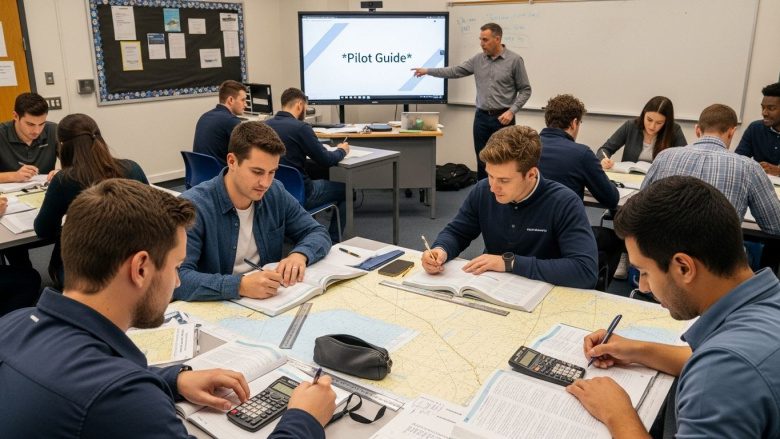Many dream of taking the controls and flying a helicopter, but figuring out how to get certified often feels like decoding a secret manual. Most people expect the requirements to be nearly impossible, maybe even out of reach unless you have decades of experience. Yet, the truth is you can qualify for a private helicopter pilot licence by age 17 and with just 45 hours of flight training—a milestone far more achievable than most imagine.
Table of Contents
- Understanding Helicopter Pilot Certificate Requirements
- Steps Involved In Helicopter Flight Training
- Choosing The Right Training School Or Academy
- Career Options With A Helicopter Pilot Certificate
Quick Summary
| Takeaway | Explanation |
|---|---|
| Meet medical and age requirements | Ensure you are at least 17 years old and obtain an EASA Class 2 medical certificate before training. |
| Complete required training hours | For a Private Pilot Licence, you need a total of at least 45 flight hours, including solo and cross-country experiences. |
| Pass theoretical and practical exams | Successfully complete written and practical evaluations to confirm your knowledge and flying skills before certification. |
| Choose a reputable training school | Select an accredited training organisation with experienced instructors and a strong safety record to ensure quality education. |
| Explore diverse career opportunities | A helicopter pilot certificate offers roles in commercial aviation, emergency services, and specialized fields like agriculture and research. |
Understanding Helicopter Pilot Certificate Requirements
Becoming a helicopter pilot requires navigating a complex set of legal, medical, and training requirements. The journey to earning your helicopter pilot certificate involves multiple crucial steps and careful preparation across different licensing levels.
Medical and Age Requirements
Before you can soar through the skies, you must meet specific medical and age criteria. According to European Union Aviation Safety Agency (EASA), helicopter pilot licensing involves strict medical standards. For a Private Pilot Licence (PPL), you must be at least 17 years old and obtain an EASA Class 2 medical certificate. This medical examination ensures you possess the physical and mental capabilities necessary for safe helicopter operation.
The medical assessment covers various health aspects including vision, hearing, cardiovascular health, and neurological functions. Potential pilots must demonstrate fitness without significant medical conditions that could compromise flight safety. An approved aeromedical examiner conducts comprehensive tests to validate your medical fitness for flying.
Training and Flight Hour Requirements
Training represents the most significant component of obtaining a helicopter pilot certificate. Professional Helicopter Pilots Association recommends a structured approach to accumulating required flight hours and theoretical knowledge. For a Private Pilot Licence (PPL), aspiring pilots must complete a minimum of 45 flight training hours, including:
- At least 10 hours of solo flight time
- Minimum 5 hours of solo cross-country flight experience
- Comprehensive theoretical knowledge training in critical areas such as:
- Air law
- Flight performance
- Meteorology
- Human performance
Advanced certifications like Commercial Pilot Licence (CPL) demand more rigorous requirements. Candidates must be at least 18 years old and accumulate approximately 150 total flight hours, demonstrating significantly more advanced skills and knowledge.
The following table summarises the main requirements for obtaining both a Private and Commercial Helicopter Pilot Licence, making it easier to compare the criteria for each level.
| Requirement | Private Pilot Licence (PPL) | Commercial Pilot Licence (CPL) |
|---|---|---|
| Minimum Age | 17 years | 18 years |
| Medical Certificate | EASA Class 2 | EASA Class 1 |
| Minimum Flight Hours | 45 | 150 |
| Solo Flight Hours (Min.) | 10 | (Included in total) |
| Solo Cross-Country Hours (Min.) | 5 | (Included in total) |
| Theoretical Knowledge Required | Yes | Yes |
| Examinations (Written & Practical) | Yes | Yes |
Theoretical and Practical Examinations
Earning a helicopter pilot certificate involves passing both theoretical and practical examinations. These assessments validate your comprehensive understanding of aviation principles and your ability to safely operate a helicopter under various conditions. The examination process typically includes written tests covering complex aviation topics and practical flight assessments where you demonstrate your piloting skills.
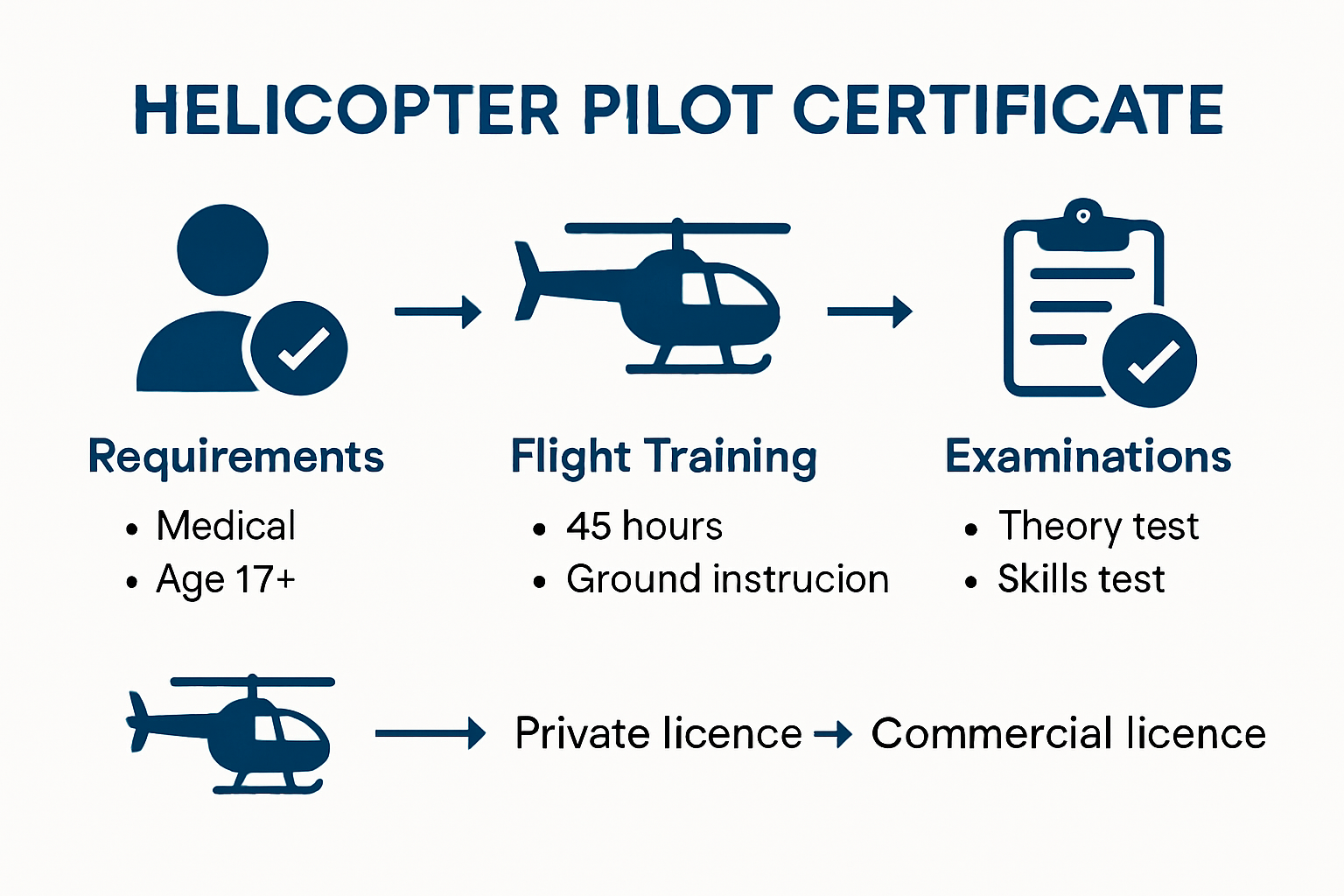
Theoretical exams test your knowledge across multiple domains including navigation, aircraft systems, meteorological interpretation, and emergency procedures. Practical examinations assess your real-world flying capabilities, requiring precise manoeuvres, decision-making skills, and comprehensive understanding of helicopter operations.
For those passionate about pursuing a helicopter pilot career, our comprehensive pilot training guide offers invaluable insights into navigating these complex requirements and preparing effectively for your certification journey.
Steps Involved in Helicopter Flight Training
Helicopter flight training is a structured and comprehensive process that transforms aspiring pilots into skilled aviation professionals. Understanding the precise steps involved can help you navigate this complex journey with confidence and clarity.
This table outlines the core steps involved in helicopter flight training to help prospective pilots quickly understand the training process from theory to certification.
| Step | Description |
|---|---|
| Ground School | Intensive coursework covering air law, navigation, meteorology, and more |
| Introductory Flights | Initial hands-on experience with helicopter controls and basic manoeuvres |
| Dual Control Training | Instruction with a certified flight instructor in control-sharing mode |
| Solo Flight Experience | Independent flying under controlled, supervised conditions |
| Advanced Manoeuvres | Training in complex techniques such as hovering and emergency procedures |
| Final Examinations | Theoretical and practical assessments to demonstrate knowledge and flying skills |
| Certification | Issue of official pilot licence upon successful completion |
Ground School and Theoretical Knowledge
Before touching a helicopter’s controls, pilots must build a robust foundation of theoretical knowledge. According to European Union Aviation Safety Agency (EASA), ground school training covers critical areas essential for safe helicopter operations. These comprehensive theoretical modules include:
- Air Law: Understanding aviation regulations and legal frameworks
- Navigation: Learning complex navigation techniques and systems
- Meteorology: Interpreting weather patterns and their impact on flight
- Flight Principles: Studying aerodynamics and helicopter mechanics
- Human Performance: Understanding physiological and psychological factors affecting pilot performance
Typically, ground school involves 150-200 hours of intensive classroom or online learning, where students engage with complex aviation concepts through interactive lectures, simulations, and practice examinations.
Practical Flight Training
Practical flight training represents the most critical phase of helicopter pilot certification. Professional Helicopter Pilots Association emphasizes that hands-on experience is crucial for developing real-world flying skills. Training usually follows a structured progression:
- Introductory Flights: Initial familiarization with helicopter controls and basic manoeuvres
- Dual Control Training: Learning under direct instructor supervision
- Solo Flight Experience: Independent flying under controlled conditions
- Advanced Manoeuvres: Complex techniques like hovering, autorotation, and emergency procedures
For a Private Pilot Licence (PPL), candidates must complete a minimum of 45 flight training hours, including at least 10 hours of solo flight time and 5 hours of cross-country experience. Commercial Pilot Licence (CPL) candidates require approximately 150 total flight hours, demonstrating more advanced skills and operational complexity.
Final Assessment and Certification
The culmination of helicopter flight training involves rigorous theoretical and practical examinations. These comprehensive assessments validate a pilot’s knowledge, skills, and readiness for professional aviation. Practical examinations test precise manoeuvring, decision-making abilities, and comprehensive understanding of helicopter operations.
Examiners evaluate candidates across multiple domains, including:
- Precise flight control
- Navigation accuracy
- Emergency procedure management
- Situational awareness
- Communication skills
Successful completion of these assessments grants the coveted helicopter pilot certificate, marking the transition from student to professional pilot.
For aspiring pilots seeking structured guidance, our comprehensive pilot training resources provide invaluable insights into navigating this exciting career path.
Choosing the Right Training School or Academy
Selecting the appropriate helicopter pilot training school is a critical decision that can significantly impact your aviation career trajectory. The right academy will not only provide comprehensive technical training but also shape your professional development and future opportunities.
Accreditation and Certification Standards
Before committing to any flight training organisation, verifying its official accreditation is paramount. According to European Union Aviation Safety Agency (EASA), only Approved Training Organisations (ATOs) with full certification can legally provide helicopter pilot training leading to recognised European licences.
Key accreditation factors to evaluate include:
- EASA Approval Status: Confirms the school meets rigorous European aviation training standards
- Instructor Qualifications: Experienced instructors with current commercial helicopter flying credentials
- Training Fleet: Modern, well-maintained helicopter training aircraft
- Safety Record: Documented history of safe training operations
- Success Rates: Percentage of students successfully obtaining their pilot licences
Training Programme Evaluation
Professional Helicopter Pilots Association recommends a comprehensive approach to evaluating training programmes. Beyond basic accreditation, aspiring pilots should assess the depth and flexibility of the curriculum. Look for academies offering:
- Integrated and modular training pathways
- Comprehensive theoretical and practical instruction
- Advanced simulation technologies
- Realistic scenario-based training
- Potential career progression opportunities
Consider the school’s reputation within the aviation industry, alumni success stories, and relationships with potential employers. Some academies provide additional career support services, which can be invaluable when transitioning from student to professional pilot.
Financial and Logistical Considerations
Helicopter pilot training represents a significant financial investment. Helicopter Association International suggests carefully evaluating the total cost of training, including tuition, flight hours, equipment, and potential additional expenses.
Important financial factors include:
- Transparent fee structures
- Potential financing or scholarship options
- Payment plans
- Cost per flight hour
- Additional expenses for study materials and equipment
Consider the academy’s location, training schedule flexibility, and accommodation options. Some students might prefer local training, while others might be open to international programmes that offer unique experiences and global perspectives.
For those seeking detailed guidance on selecting the optimal pilot training path, our comprehensive pilot training guide provides in-depth insights to help you make an informed decision about your aviation education journey.
Career Options with a Helicopter Pilot Certificate
A helicopter pilot certificate opens doors to diverse and exciting career opportunities across multiple industries. Far beyond traditional aviation roles, helicopter pilots can pursue unique professional paths that combine technical skill, adventure, and meaningful service.
Commercial and Corporate Aviation
Commercial helicopter operations represent a significant career pathway for licensed pilots. According to International Helicopter Association, commercial pilots can find employment in various specialized sectors. Corporate transportation offers lucrative opportunities, with companies using helicopters for executive travel, site inspections, and rapid inter-city transportation.
Key commercial aviation roles include:
- Corporate Flight Pilot: Transporting executives and managing business-critical aerial logistics
- Charter Service Pilot: Operating scheduled and on-demand helicopter transportation
- Offshore Oil and Gas Industry Pilot: Supporting maritime and offshore platform operations
- Aerial Survey and Mapping Pilot: Conducting geographical and infrastructure surveys
Emergency Services and Public Safety
National Emergency Services Association highlights the critical role helicopter pilots play in public safety and emergency response. These professionals provide essential services that can directly save lives and support communities during critical situations.
Emergency service career opportunities encompass:
- Medical Evacuation (Medevac) Pilot: Transporting patients from remote or challenging locations
- Search and Rescue Pilot: Conducting complex rescue operations in difficult terrain
- Firefighting Support Pilot: Assisting wildfire management and aerial fire suppression
- Law Enforcement Aviation Support: Supporting police and government agencies
Specialized Industrial and Scientific Applications
Helicopter pilots can also explore unique career paths in specialized industrial and scientific domains. These roles often require advanced technical skills and provide opportunities to contribute to research, environmental protection, and infrastructure development.
Specialized career options include:
- Agricultural Aviation Pilot: Performing crop monitoring, precision agricultural spraying
- Environmental Research Pilot: Supporting scientific expeditions and ecological studies
- Infrastructure Inspection Pilot: Monitoring power lines, pipelines, and critical infrastructure
- Geological and Mineral Exploration Pilot: Supporting resource exploration in remote regions
Each of these career paths demands not just technical flying skills, but also specialized knowledge, adaptability, and a commitment to professional excellence. Continuous training and additional certifications can further enhance career prospects and earning potential.
For aspiring pilots looking to explore the full spectrum of career opportunities, our comprehensive pilot career guide offers detailed insights into navigating the exciting world of helicopter aviation.
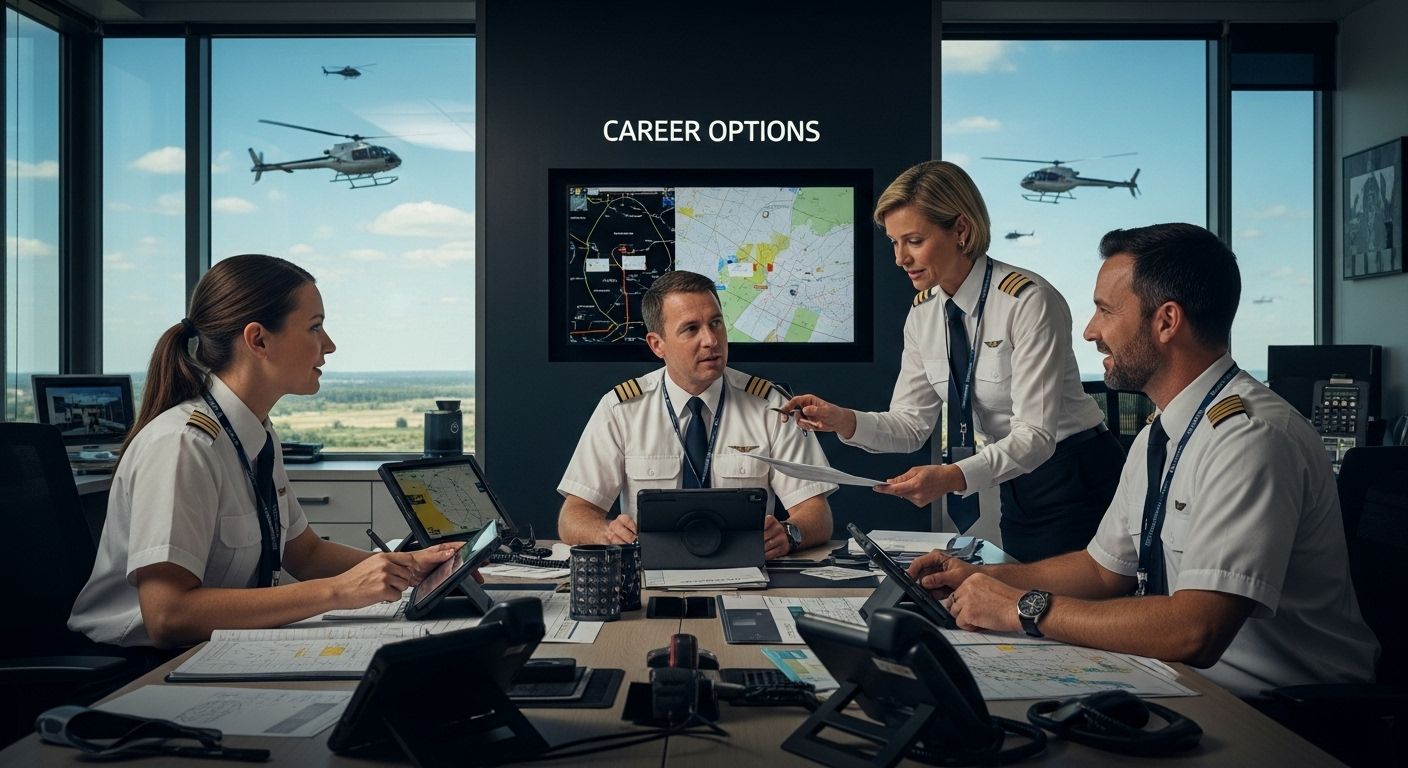
Frequently Asked Questions
What are the age and medical requirements to obtain a helicopter pilot certificate?
To obtain a Private Pilot Licence (PPL), you must be at least 17 years old and obtain an EASA Class 2 medical certificate, which ensures you meet the necessary physical and mental health standards.
How many flight training hours are required for a Private Pilot Licence?
You need a minimum of 45 flight training hours, which must include at least 10 hours of solo flight time and a minimum of 5 hours of solo cross-country flight experience.
What examinations must I pass to earn my helicopter pilot certificate?
You must pass both theoretical examinations, which cover topics such as air law, navigation, and meteorology, and practical examinations that assess your flying skills and decision-making in real-world scenarios.
How do I choose the right helicopter training school?
When selecting a training school, ensure it is an accredited organisation, assess the qualifications of instructors, review the training programmes offered, and consider the school’s safety record and success rates.
Ready to Take Off? Bridge the Gap to Your Helicopter Pilot Certificate with Confidence
If you have felt overwhelmed by the strict requirements, complex theory, or the sheer challenge of gathering flight hours and preparing for both written and practical exams, you are not alone. Many future pilots worry about finding a reliable, flexible way to complete their compulsory EASA theoretical courses, pass ICAO phraseology assessments, or gain the right foundational knowledge for PPL(H) and CPL(H) certification.
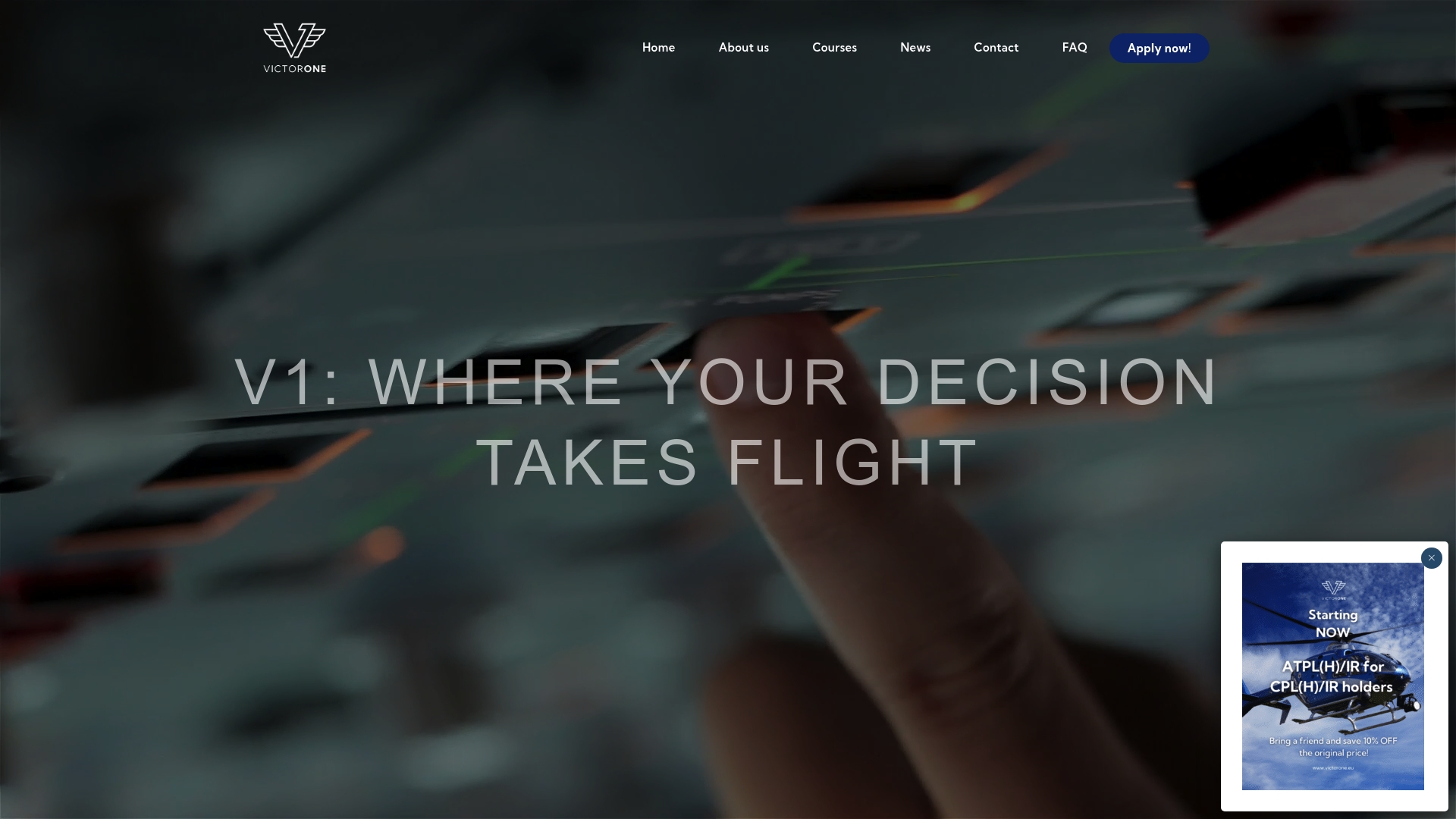
VictorOne.eu takes the uncertainty out of your journey. Our online aviation courses are developed for those who want results without wasting time or resources. Study anywhere and at your own pace. Enjoy international access to EASA-approved helicopter theory lessons and licencing exam support, including specialist bridge courses for career progression. Do not wait to begin your dream. Visit VictorOne.eu and make your next step towards a helicopter pilot career simple and achievable today.

